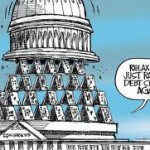
Absent action by Congress near the end of February, the Treasury Department will have exhausted all internal accounting measures to continue its operations without the necessity of additional borrowing beyond the statutorily-mandated debt limit of $16.4 trillion, which the US reached on New Year’s Eve.
But what happens then?
The public narrative, informed by both pundits and press, is that the US will immediately default on its debt, with all the massive collateral damage that would occur in international financial markets as well as the significant knock-on impact to the global economy. For an example, look no further than Zachary Goldfarb’s alarmist article in the Washington Post on January 7th.
But a closer look at the facts shows that this causal relationship between the debt limit and default is simply not true. Specifically, that a failure to raise the debt limit by a date certain would create a sovereign default.
While it is a fact that the impact of any delay in raising the debt limit would have its own real and profound implications, it is nevertheless necessary to note that immediate sovereign default is not among them.
Here is why.
For a sovereign default to occur, the US would have to suspend interest payments on our public debt owed to outside creditors. In 2012, the US paid $223 billion in interest payments to finance that debt, and keep its credit in good standing.
Now, despite the record deficits of the past four years, US government revenues have continued to grow since 2009. In 2012, (with the Bush tax cuts fully in place, by the way) revenues to the Treasury totaled $2.4 trillion, very close to the historic revenues that were collected in 2007.
So by the logic of simple math, servicing the debt costs about 10 percent of the total amount of revenue taken in by the government. Taken to the next level, if the debt limit were not reached, there would still be more than enough revenue for the US to service the country’s debt burden, with significant funds to spare. Indeed, based on the 2012 numbers, the US could pay its interest obligations, all Social Security obligations, Medicare obligations and fund the defense budget at ’12 levels, and still have $300 billion left over for other programs, where priorities would obviously need to be set. Those additional program costs for 2012 are listed below:
| Program | Budget |
| Health | 347B |
| Veterans | 125B |
| Transportation | 91B |
| Education | 89B |
| Justice | 58B |
| Int’l Affairs | 47B |
| Natural Resources/Enviro | 42B |
| Commerce | 40B |
| Science Space/Tech. | 29B |
| General Gov’t | 23B |
| Agriculture | 20B |
| Energy | 15B |
Clearly, failure the resolve the debt limit issue leaves the US budget with a giant hole as it pertains to current spending. Failure to resolve the problme would necessarily require radical and draconian cuts in domestic spending, which would come with their own significant economic and political costs due to disruption and uncertainty.
But no matter how damaging, that is not the same as a sovereign default.
President Obama has repeated over and over again that Congress must authorize a debt ceiling increase to pay for the funds thatit has already spent. But that is not actually true. Existing revenues can easily service the debt.
Rather, the President and Democrats are requesting that Congress increase the national debt ceiling – without conditions, mind you – so that the government can authorize future spending/borrowing, an activity that has no relationship to the existing debt.
Thus, this is not about financing/defaulting on past obligations; this is a debate about spending that has not yet occurred.
Indeed, despite popular misrepresentation, the GOP is no more interested in defaulting on US obligations than President Obama and the Democrats.
The coming debate is not about servicing the debt, it is about the size of government, and our choices and priorities in how we pay for that government. Given the record $6 trillion in new debt the nation has accumulated in only four years, the GOP believes that a deal on new borrowing must be linked to long-term spending restraint, if the nation is going to have any shot at containing debt, growing the economy and creating jobs.
The President and Democrats want a blank check.
So as we get closer to February, keep these facts in mind.
President Obama and Democrats, with the help of a pliable media, have conflated two distinct issues – a true sovereign default triggered through suspension of interest payments on the debt, and the inability to fund the US government at its current level through lack of borrowing authority, as the same thing.
They are not the same thing. And this is crucial for another reason.
Democratic partisans are urging the President to take extraordinary measures to resolve the debt ceiling crisis on his own terms. For instance, to use a (inapplicable) provision of the 14th Amendment that mentions the public debt as executive power to unilaterally raise the debt limit. Or even the preposterous notion of minting a trillion dollar coin that would be deposited in with the Federal Reserve, allowing Treasury to disregard Congress entirely, and borrowing from that sum on account at the Fed, directly.
Both measures require as a foundational principle that a failure to raise the debt limit translates directly into an inability of the US to finance its debts with creditors. That is simply not true, making the measures not only suspect, but constitutionally dangerous.
The distinction is everything, and will likely define who comes out on top in the debt limit negotiations.
Prepare for the unexpected.
